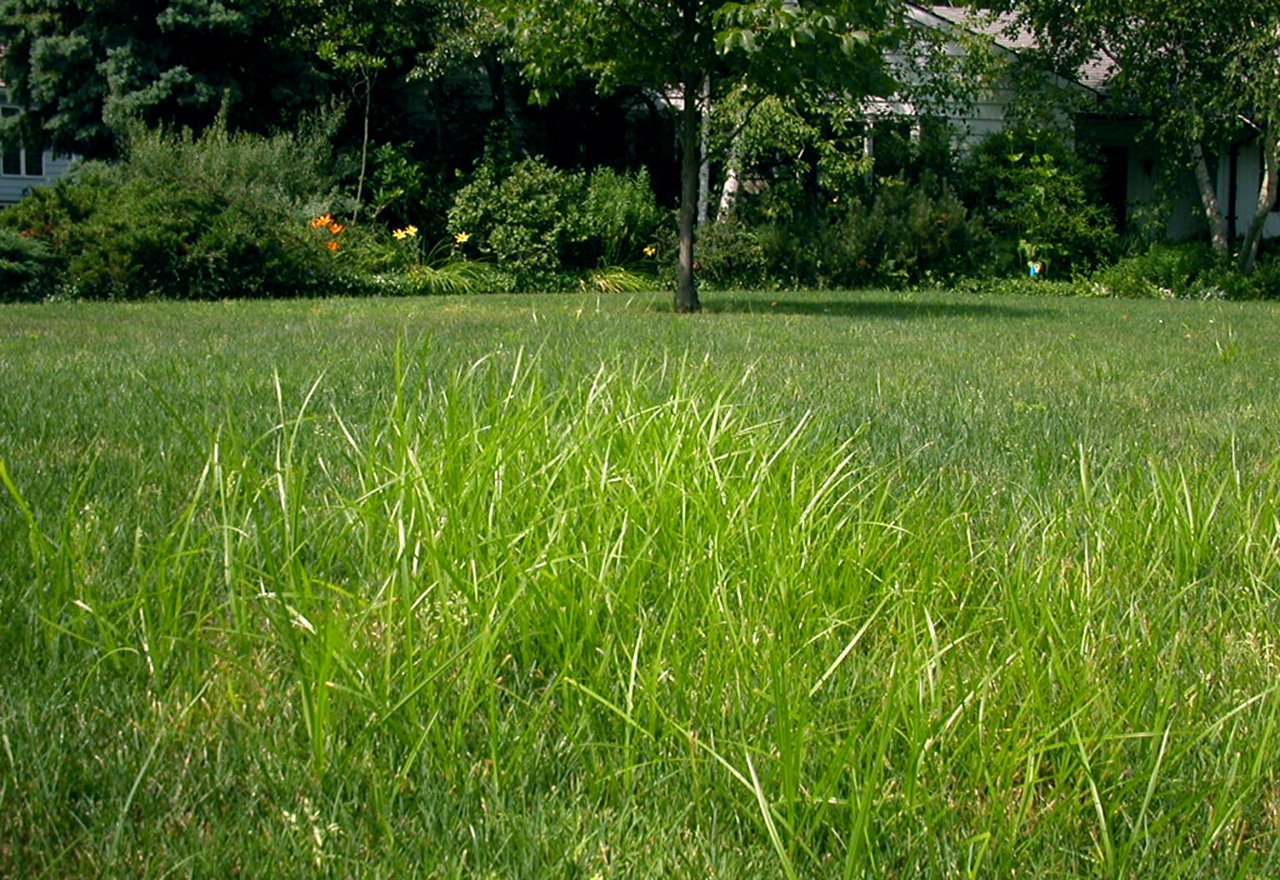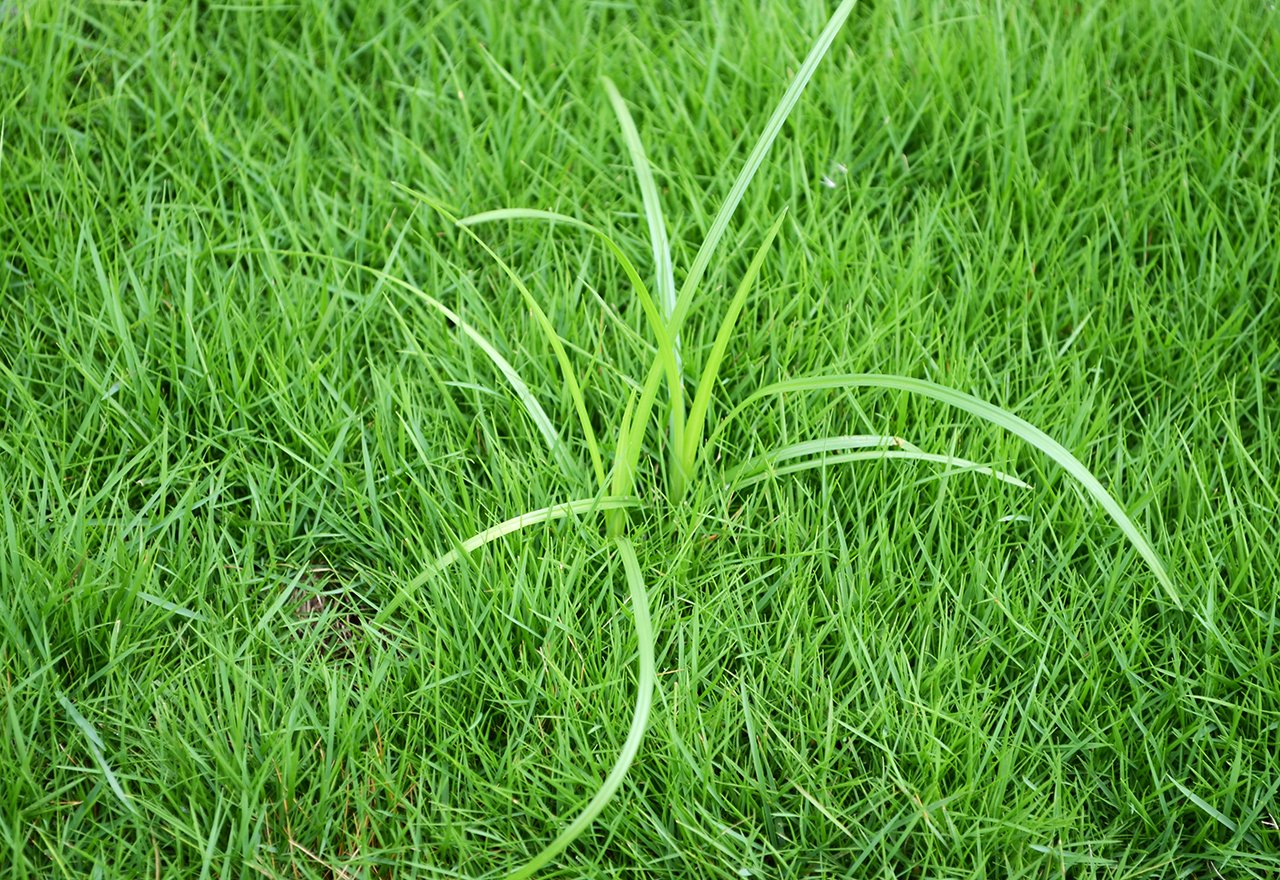Nutsedge is a Sedge, not a Grass and Thrives in Warm, Wet Conditions

Yellow Nutsedge (Cyperus esculentus) is a common turfgrass weed in the Midwest. It looks a lot like grass, but is brighter yellow-green and shinier than turfgrass. It also grows faster than grass at the height of the Summer and therefore pokes above the rest of the lawn. When picked, you can tell that Yellow Nutsedge is not grass because the stem is not flat, but instead triangular. Additionally, the base of Yellow Nutsedge is purple-pink, not green or brown like grass. This turf weed thrives under warm, wet conditions and can often be found in low, damp areas of lawns. Sedges are generally wetland plants and so are an indicator of a wet or poorly drained area of your yard (or possibly an irrigation leak). This weed is often most problematic during Summers with above-normal rainfall. Once established, Yellow Nutsedge will spread to other parts of the lawn that are not as damp.
Like most sedges, Yellow Nutsedge is a perennial plant that propagates via tubers. In Nutsedges however, these tubers are called nutlets. The nutlets grow from the end of underground stems, rhizomes. Yellow Nutsedge also reproduces via seeds that are distributed by feathery green flowers. The flowers rarely form when Yellow Nutsedge is present in a lawn though, since it is always mowed short. Nutsedge will die off at the first hard frost and lay dormant throughout the Winter.
Yellow Nutsedge is also called chufa, nutgrass, or watergrass. It can also be a problem in agricultural fields and gardens.
Various factors will lead to increased populations of Yellow Nutsedge, including improper mowing, insect damage, and drought stress, which reduces the competitive ability of desirable turfgrasses to thrive. Yellow Nutsedge easily out-competes grass that is mowed too low.
Yellow Nutsedge can be extremely hard to get rid of because of its underground growth. Hand digging can work if there are just a few clumps of the plants in your lawn, but you must fully remove all rhizomes and nutlets. It’s recommended to dig a trench around the Yellow Nutsedge-infested area to fully remove all underground growth. The best time to do this is in the Spring, after the initial burst of growth and before new tuber growth. Continue to check the same area for new growth and immediately remove it throughout the Summer. It may be best to fully remove and replace the soil in this area to ensure all nutlets and rhizomes are gone.
Additionally, reducing watering sessions will inhibit the spread of Yellow Nutsedge. This way, your soil moisture will change and reduce the optimal growing conditions. We also recommend Liquid Aeration in the Spring and Fall to help your soil drain better. If you prefer to tackle the issue yourself, you can purchase and apply Liquid Aerator, which will help loosen the soil and improve your lawn’s resistance to Yellow Nutsedge. As a last resort, there are chemicals that will kill Nutsedge, without killing the grass, but they are not organic in nature.
Mowing well, and encouraging healthy grass growth is another helpful habit that will reduce all weeds in your lawn. We recommend mowing your grass higher than you (or your neighbors) may be used to: three and a half to four and a half inches. This will encourage your grass to grow deeper roots, which will mean healthier grass in general. Also, be sure your mower blades are sharp so that you aren’t harming the individual grass blades. Let your grass clippings stay on your yard to break down and fertilize the soil.
We also like to add a bit of Microclover to yards. The variety we sell is small and won’t flower. Clover is a legume and so will add nitrogen to your soil, which will feed your grass – a natural fertilizer! Also, Microclover remains bright green the entire Summer when grass sometimes turns “golden” in the heat of the Summer. We recommend Slice Seeding in Microclover where you have thin areas, along with our favorite Tuff Turf Lawn Seed, which is a mixture of Turf Type Tall Fescue and Kentucky Bluegrass, ideal for the Midwest. Lastly we recommend an annual double Spring dose of our natural fertilizer. Good Nature Earth Turf, that encourages grass thickness.
Yellow Nutsedge is edible. The nutlets taste nutty and can add texture and sweetness to smoothies, stews, and soups. Ancient Egyptians ate them, as did the people of Spain. As always, be sure you know what you are foraging before consuming!
